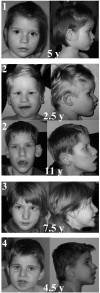Mutations in TCF4, encoding a class I basic helix-loop-helix transcription factor, are responsible for Pitt-Hopkins syndrome, a severe epileptic encephalopathy associated with autonomic dysfunction
- PMID: 17436254
- PMCID: PMC1852736
- DOI: 10.1086/515582
Mutations in TCF4, encoding a class I basic helix-loop-helix transcription factor, are responsible for Pitt-Hopkins syndrome, a severe epileptic encephalopathy associated with autonomic dysfunction
Abstract
Pitt-Hopkins syndrome (PHS) is a rare syndromic encephalopathy characterized by daily bouts of hyperventilation and a facial gestalt. We report a 1.8-Mb de novo microdeletion on chromosome 18q21.1, identified by array-comparative genomic hybridization in one patient with PHS. We subsequently identified two de novo heterozygous missense mutations of a conserved amino acid in the basic region of the TCF4 gene in three additional subjects with PHS. These findings demonstrate that TCF4 anomalies are responsible for PHS and provide the first evidence of a human disorder related to class I basic helix-loop-helix transcription-factor defects (also known as "E proteins"). Moreover, our data may shed new light on the normal processes underlying autonomic nervous system development and maintenance of an appropriate ventilatory neuronal circuitry.
Figures



Similar articles
-
Haploinsufficiency of TCF4 causes syndromal mental retardation with intermittent hyperventilation (Pitt-Hopkins syndrome).Am J Hum Genet. 2007 May;80(5):994-1001. doi: 10.1086/515583. Epub 2007 Mar 23. Am J Hum Genet. 2007. PMID: 17436255 Free PMC article.
-
Disruption of the TCF4 gene in a girl with mental retardation but without the classical Pitt-Hopkins syndrome.Am J Med Genet A. 2008 Aug 15;146A(16):2053-9. doi: 10.1002/ajmg.a.32419. Am J Med Genet A. 2008. PMID: 18627065
-
Severe mental retardation with breathing abnormalities (Pitt-Hopkins syndrome) is caused by haploinsufficiency of the neuronal bHLH transcription factor TCF4.Hum Mol Genet. 2007 Jun 15;16(12):1488-94. doi: 10.1093/hmg/ddm099. Epub 2007 May 3. Hum Mol Genet. 2007. PMID: 17478476
-
The emerging roles of TCF4 in disease and development.Trends Mol Med. 2014 Jun;20(6):322-31. doi: 10.1016/j.molmed.2014.01.010. Epub 2014 Mar 1. Trends Mol Med. 2014. PMID: 24594265 Review.
-
Transcription factor 4 and its association with psychiatric disorders.Transl Psychiatry. 2021 Jan 5;11(1):19. doi: 10.1038/s41398-020-01138-0. Transl Psychiatry. 2021. PMID: 33414364 Free PMC article. Review.
Cited by
-
The second brain in autism spectrum disorder: could connexin 43 expressed in enteric glial cells play a role?Front Cell Neurosci. 2015 Jul 3;9:242. doi: 10.3389/fncel.2015.00242. eCollection 2015. Front Cell Neurosci. 2015. PMID: 26190971 Free PMC article. No abstract available.
-
Transcription factor 4 gene rs9960767 polymorphism in bipolar disorder.Biomed Rep. 2016 Oct;5(4):506-510. doi: 10.3892/br.2016.742. Epub 2016 Aug 23. Biomed Rep. 2016. PMID: 27699022 Free PMC article.
-
Genetic determinants of autism in individuals with deletions of 18q.Hum Genet. 2010 Aug;128(2):155-64. doi: 10.1007/s00439-010-0839-y. Epub 2010 May 25. Hum Genet. 2010. PMID: 20499253
-
A novel microdeletion syndrome involving 5q14.3-q15: clinical and molecular cytogenetic characterization of three patients.Eur J Hum Genet. 2009 Dec;17(12):1592-9. doi: 10.1038/ejhg.2009.90. Epub 2009 May 27. Eur J Hum Genet. 2009. PMID: 19471318 Free PMC article.
-
Whole genome sequencing of 45 Japanese patients with intellectual disability.Am J Med Genet A. 2021 May;185(5):1468-1480. doi: 10.1002/ajmg.a.62138. Epub 2021 Feb 24. Am J Med Genet A. 2021. PMID: 33624935 Free PMC article.
References
Web Resources
-
- Ensembl Genome Browser, http://www.ensembl.org/
-
- GenBank, http://www.ncbi.nlm.nih.gov/Genbank/ (for TCF4 [accession number NM_003199])
-
- National Center for Biotechnology Information, http://www.ncbi.nlm.nih.gov/
-
- Online Mendelian Inheritance in Man (OMIM), http://www.ncbi.nlm.nih.gov/Omim/ (for TCF4, MBD2, ASCL1, HOX11L2, Mowat-Wilson syndrome, Goldberg-Shprintzen syndrome, Rett syndrome, and Angelman syndrome)
Publication types
MeSH terms
Substances
Associated data
- Actions
- Actions
Grants and funding
LinkOut - more resources
Full Text Sources
Other Literature Sources
Medical
Molecular Biology Databases
Miscellaneous

